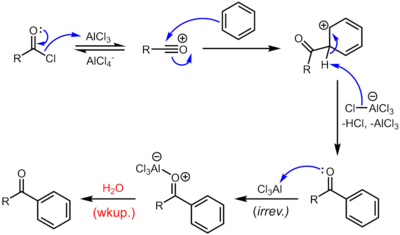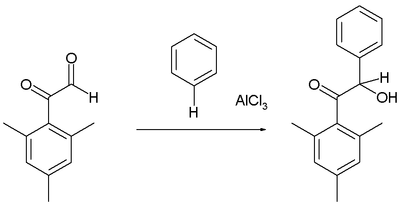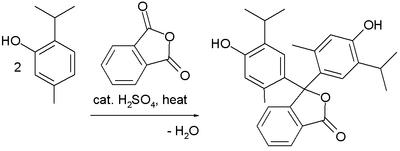Friedel–Crafts reaction: Difference between revisions
Extended confirmed users 2,517 edits →Alkenes as alkylating agents: + reaction images |
Extended confirmed users 2,017 edits m Altered section headers Tags: Visual edit Mobile edit Mobile web edit Advanced mobile edit |
||
| Line 11: | Line 11: | ||
The '''Friedel–Crafts reactions''' are a set of [[organic reaction|reactions]] developed by [[Charles Friedel]] and [[James Crafts]] in 1877 to attach substituents to an [[Aromatic hydrocarbon|aromatic ring]].<ref>Friedel, C.; Crafts, J. M. (1877) "Sur une nouvelle méthode générale de synthèse d'hydrocarbures, d'acétones, etc.," ''Compt. Rend.'', '''84''': [http://gallica.bnf.fr/ark:/12148/bpt6k30410/f1386.table 1392] & [http://gallica.bnf.fr/ark:/12148/bpt6k30410/f1444.table 1450].</ref> Friedel–Crafts reactions are of two main types: [[alkylation]] reactions and [[acylation]] reactions. Both proceed by [[electrophilic aromatic substitution]].<ref>{{Cite journal |last=Price, C. C. |year=1946 |title=The Alkylation of Aromatic Compounds by the Friedel-Crafts Method |journal=Org. React. |volume=3 |page=1 |doi=10.1002/0471264180.or003.01 |isbn=0471264180}}</ref><ref>{{Cite journal |last=Groves, J. K. |year=1972 |title=The Friedel–Crafts acylation of alkenes |journal=[[Chem. Soc. Rev.]] |volume=1 |page=73 |doi=10.1039/cs9720100073}}</ref><ref>{{Cite journal |last=Eyley, S. C. |year=1991 |title=The Aliphatic Friedel–Crafts Reaction |journal=Compr. Org. Synth. |volume=2 |pages=707–731 |doi=10.1016/B978-0-08-052349-1.00045-7 |isbn=978-0-08-052349-1}}</ref><ref>{{Cite journal |last=Heaney, H. |year=1991 |title=The Bimolecular Aromatic Friedel–Crafts Reaction |journal=Compr. Org. Synth. |volume=2 |pages=733–752 |doi=10.1016/B978-0-08-052349-1.00046-9 |isbn=978-0-08-052349-1}}</ref> |
The '''Friedel–Crafts reactions''' are a set of [[organic reaction|reactions]] developed by [[Charles Friedel]] and [[James Crafts]] in 1877 to attach substituents to an [[Aromatic hydrocarbon|aromatic ring]].<ref>Friedel, C.; Crafts, J. M. (1877) "Sur une nouvelle méthode générale de synthèse d'hydrocarbures, d'acétones, etc.," ''Compt. Rend.'', '''84''': [http://gallica.bnf.fr/ark:/12148/bpt6k30410/f1386.table 1392] & [http://gallica.bnf.fr/ark:/12148/bpt6k30410/f1444.table 1450].</ref> Friedel–Crafts reactions are of two main types: [[alkylation]] reactions and [[acylation]] reactions. Both proceed by [[electrophilic aromatic substitution]].<ref>{{Cite journal |last=Price, C. C. |year=1946 |title=The Alkylation of Aromatic Compounds by the Friedel-Crafts Method |journal=Org. React. |volume=3 |page=1 |doi=10.1002/0471264180.or003.01 |isbn=0471264180}}</ref><ref>{{Cite journal |last=Groves, J. K. |year=1972 |title=The Friedel–Crafts acylation of alkenes |journal=[[Chem. Soc. Rev.]] |volume=1 |page=73 |doi=10.1039/cs9720100073}}</ref><ref>{{Cite journal |last=Eyley, S. C. |year=1991 |title=The Aliphatic Friedel–Crafts Reaction |journal=Compr. Org. Synth. |volume=2 |pages=707–731 |doi=10.1016/B978-0-08-052349-1.00045-7 |isbn=978-0-08-052349-1}}</ref><ref>{{Cite journal |last=Heaney, H. |year=1991 |title=The Bimolecular Aromatic Friedel–Crafts Reaction |journal=Compr. Org. Synth. |volume=2 |pages=733–752 |doi=10.1016/B978-0-08-052349-1.00046-9 |isbn=978-0-08-052349-1}}</ref> |
||
== |
== Alkylation ==<!-- This section is linked from [[Cumene process]] --> |
||
{{Reactionbox |
{{Reactionbox |
||
| Name = Friedel-Crafts alkylation |
| Name = Friedel-Crafts alkylation |
||
| Line 21: | Line 21: | ||
}} |
}} |
||
}} |
}} |
||
===With alkyl halides |
===With alkyl halides=== |
||
Friedel–Crafts alkylation involves the [[alkylation]] of an [[aromatic ring]]. Traditionally, the alkylating agents are [[alkyl halide]]s. Many alkylating agents can be used instead of alkyl halides. For example, [[enone]]s and [[epoxide]]s can be used in presence of protons. Traditionally also, the reaction employs a strong [[Lewis acid]], such as [[aluminium chloride]] as catalyst.<ref>{{Cite journal |last1=Rueping, M. |last2=Nachtsheim, B. J. |year=2010 |title=A review of new developments in the Friedel–Crafts alkylation – From green chemistry to asymmetric catalysis |journal=Beilstein J. Org. Chem. |volume=6 |issue=6 |pages=6 |doi=10.3762/bjoc.6.6 |pmc=2870981 |pmid=20485588}}</ref> |
Friedel–Crafts alkylation involves the [[alkylation]] of an [[aromatic ring]]. Traditionally, the alkylating agents are [[alkyl halide]]s. Many alkylating agents can be used instead of alkyl halides. For example, [[enone]]s and [[epoxide]]s can be used in presence of protons. Traditionally also, the reaction employs a strong [[Lewis acid]], such as [[aluminium chloride]] as catalyst.<ref>{{Cite journal |last1=Rueping, M. |last2=Nachtsheim, B. J. |year=2010 |title=A review of new developments in the Friedel–Crafts alkylation – From green chemistry to asymmetric catalysis |journal=Beilstein J. Org. Chem. |volume=6 |issue=6 |pages=6 |doi=10.3762/bjoc.6.6 |pmc=2870981 |pmid=20485588}}</ref> |
||
| Line 29: | Line 29: | ||
Furthermore, the reaction is only useful for primary alkyl halides in an intramolecular sense when a 5- or 6-membered ring is formed. For the intermolecular case, the reaction is limited to [[tertiary carbon|tertiary]] alkylating agents, some secondary alkylating agents (ones for which carbocation rearrangement is degenerate), or alkylating agents that yield stabilized carbocations (e.g., benzylic or allylic ones). In the case of primary alkyl halides, the carbocation-like complex (R<sup>(+)</sup>---X---Al<sup>(-)</sup>Cl<sub>3</sub>) will undergo a [[carbocation]] [[rearrangement reaction]] to give almost exclusively the rearranged product derived from a secondary or tertiary carbocation.<ref name="Smith2007" /> |
Furthermore, the reaction is only useful for primary alkyl halides in an intramolecular sense when a 5- or 6-membered ring is formed. For the intermolecular case, the reaction is limited to [[tertiary carbon|tertiary]] alkylating agents, some secondary alkylating agents (ones for which carbocation rearrangement is degenerate), or alkylating agents that yield stabilized carbocations (e.g., benzylic or allylic ones). In the case of primary alkyl halides, the carbocation-like complex (R<sup>(+)</sup>---X---Al<sup>(-)</sup>Cl<sub>3</sub>) will undergo a [[carbocation]] [[rearrangement reaction]] to give almost exclusively the rearranged product derived from a secondary or tertiary carbocation.<ref name="Smith2007" /> |
||
===Mechanism=== |
==== Mechanism ==== |
||
The general mechanism for primary alkyl halides is shown below.<ref name="Smith2007">{{March6th}}</ref> |
The general mechanism for primary alkyl halides is shown below.<ref name="Smith2007">{{March6th}}</ref> |
||
:[[File:Friedel-Crafts-Alkylierung 2.svg|thumb|center|upright=2.5|Mechanism of Friedel–Crafts alkylation.]] |
:[[File:Friedel-Crafts-Alkylierung 2.svg|thumb|center|upright=2.5|Mechanism of Friedel–Crafts alkylation.]] |
||
| Line 35: | Line 36: | ||
For primary (and possibly secondary) alkyl halides, a carbocation-like complex with the Lewis acid, [R<sup>(+)</sup>---(X---MX''<sub>n</sub>'')<sup>(–)</sup>] is more likely to be involved, rather than a free carbocation. |
For primary (and possibly secondary) alkyl halides, a carbocation-like complex with the Lewis acid, [R<sup>(+)</sup>---(X---MX''<sub>n</sub>'')<sup>(–)</sup>] is more likely to be involved, rather than a free carbocation. |
||
===Alkenes |
===With Alkenes=== |
||
In commercial applications, the alkylating agents are generally [[alkene]]s. Protonation of alkenes generates [[carbocation]]s, the electrophiles. A laboratory-scale example by the synthesis of [[neophyl chloride]] from benzene and [[methallyl chloride]] using sulfuric acid catalyst.<ref>{{OrgSynth | doi = 10.15227/orgsyn.032.0090 | year = 1952 | title = Neophyl Chloride | author1 = Smith, W. T. Jr. |author2=Sellas, J. T.|volume=32|page=90}}</ref> |
In commercial applications, the alkylating agents are generally [[alkene]]s. Protonation of alkenes generates [[carbocation]]s, the electrophiles. A laboratory-scale example by the synthesis of [[neophyl chloride]] from benzene and [[methallyl chloride]] using sulfuric acid catalyst.<ref>{{OrgSynth | doi = 10.15227/orgsyn.032.0090 | year = 1952 | title = Neophyl Chloride | author1 = Smith, W. T. Jr. |author2=Sellas, J. T.|volume=32|page=90}}</ref> |
||
:[[File:Neophyl chloride synthesis.svg]] |
:[[File:Neophyl chloride synthesis.svg]] |
||
| Line 46: | Line 47: | ||
[[File:1,3-Diisopropylbenzene via transalkylation.svg|thumb|center|380 px|[[1,3-Diisopropylbenzene]] is produced via transalkylation, a special form of Friedel–Crafts alkylation.]] |
[[File:1,3-Diisopropylbenzene via transalkylation.svg|thumb|center|380 px|[[1,3-Diisopropylbenzene]] is produced via transalkylation, a special form of Friedel–Crafts alkylation.]] |
||
== Acylation == |
|||
== Friedel–Crafts acylation == |
|||
{{Reactionbox |
{{Reactionbox |
||
| Name = Friedel-Crafts acylation |
| Name = Friedel-Crafts acylation |
||
| Line 70: | Line 71: | ||
If desired, the resulting ketone can be subsequently reduced to the corresponding alkane substituent by either [[Wolff–Kishner reduction]] or [[Clemmensen reduction]]. The net result is the same as the Friedel–Crafts alkylation except that rearrangement is not possible.<ref>[https://www.organic-chemistry.org/namedreactions/friedel-crafts-acylation.shtm Friedel-Crafts Acylation]. Organic-chemistry.org. Retrieved on 2014-01-11.</ref> |
If desired, the resulting ketone can be subsequently reduced to the corresponding alkane substituent by either [[Wolff–Kishner reduction]] or [[Clemmensen reduction]]. The net result is the same as the Friedel–Crafts alkylation except that rearrangement is not possible.<ref>[https://www.organic-chemistry.org/namedreactions/friedel-crafts-acylation.shtm Friedel-Crafts Acylation]. Organic-chemistry.org. Retrieved on 2014-01-11.</ref> |
||
==Hydroxyalkylation== |
|||
==Friedel–Crafts hydroxyalkylation== |
|||
Arenes react with certain [[aldehyde]]s and ketones to form the hydroxyalkylated products, for example in the reaction of the [[mesityl]] derivative of [[glyoxal]] with benzene:<ref>{{Cite journal |last1=Fuson, R. C. |last2=Weinstock, H. H. |last3=Ullyot, G. E. |year=1935 |title=A New Synthesis of Benzoins. 2′,4′,6′-Trimethylbenzoin |journal=[[J. Am. Chem. Soc.]] |volume=57 |issue=10 |pages=1803–1804 |doi=10.1021/ja01313a015}}</ref> |
Arenes react with certain [[aldehyde]]s and ketones to form the hydroxyalkylated products, for example in the reaction of the [[mesityl]] derivative of [[glyoxal]] with benzene:<ref>{{Cite journal |last1=Fuson, R. C. |last2=Weinstock, H. H. |last3=Ullyot, G. E. |year=1935 |title=A New Synthesis of Benzoins. 2′,4′,6′-Trimethylbenzoin |journal=[[J. Am. Chem. Soc.]] |volume=57 |issue=10 |pages=1803–1804 |doi=10.1021/ja01313a015}}</ref> |
||
Revision as of 15:47, 23 September 2022
| Friedel-Crafts reaction | |
|---|---|
| Named after | Charles Friedel James Crafts |
| Reaction type | Coupling reaction |
| Identifiers | |
| RSC ontology ID | RXNO:0000369 |
The Friedel–Crafts reactions are a set of
Alkylation
| Friedel-Crafts alkylation | |
|---|---|
| Named after | Charles Friedel James Crafts |
| Reaction type | Coupling reaction |
| Identifiers | |
| Organic Chemistry Portal | friedel-crafts-alkylation |
| RSC ontology ID | RXNO:0000046 |
With alkyl halides
Friedel–Crafts alkylation involves the
This reaction suffers from the disadvantage that the product is more
Furthermore, the reaction is only useful for primary alkyl halides in an intramolecular sense when a 5- or 6-membered ring is formed. For the intermolecular case, the reaction is limited to tertiary alkylating agents, some secondary alkylating agents (ones for which carbocation rearrangement is degenerate), or alkylating agents that yield stabilized carbocations (e.g., benzylic or allylic ones). In the case of primary alkyl halides, the carbocation-like complex (R(+)---X---Al(-)Cl3) will undergo a carbocation rearrangement reaction to give almost exclusively the rearranged product derived from a secondary or tertiary carbocation.[8]
Mechanism
The general mechanism for primary alkyl halides is shown below.[8]
For primary (and possibly secondary) alkyl halides, a carbocation-like complex with the Lewis acid, [R(+)---(X---MXn)(–)] is more likely to be involved, rather than a free carbocation.
With Alkenes
In commercial applications, the alkylating agents are generally alkenes. Protonation of alkenes generates carbocations, the electrophiles. A laboratory-scale example by the synthesis of neophyl chloride from benzene and methallyl chloride using sulfuric acid catalyst.[9]
Such alkylations are of major industrial importance, e.g. for the production of ethylbenzene, the precursor to polystyrene, from benzene and ethylene:
Industrial production typically uses solid acids derived from a zeolite as the catalyst.
Friedel–Crafts dealkylation
Friedel–Crafts alkylations can be reversible as illustrated by many transalkylation reactions.[10]

Acylation
| Friedel-Crafts acylation | |
|---|---|
| Named after | Charles Friedel James Crafts |
| Reaction type | Coupling reaction |
| Identifiers | |
| Organic Chemistry Portal | friedel-crafts-acylation |
| RSC ontology ID | RXNO:0000045 |
Friedel–Crafts acylation involves the
The viability of the Friedel–Crafts acylation depends on the stability of the acyl chloride reagent. Formyl chloride, for example, is too unstable to be isolated. Thus, synthesis of
Reaction mechanism
The reaction proceeds through generation of an acylium center. The reaction is completed by deprotonation of the arenium ion by AlCl4−, regenerating the AlCl3 catalyst. However, in contrast to the truly catalytic alkylation reaction, the formed ketone is a moderate Lewis base, which forms a complex with the strong Lewis acid aluminum trichloride. The formation of this complex is typically irreversible under reaction conditions. Thus, a stochiometric quantity of AlCl3 is needed. The complex is destroyed upon aqueous workup to give the desired ketone. For example, the classical synthesis of deoxybenzoin calls for 1.1 equivalents of AlCl3 with respect to the limiting reagent, phenylacetyl chloride.[12] In certain cases, generally when the benzene ring is activated, Friedel–Crafts acylation can also be carried out with catalytic amounts of a milder Lewis acid (e.g. Zn(II) salts) or a Brønsted acid catalyst using the anhydride or even the carboxylic acid itself as the acylation agent.
If desired, the resulting ketone can be subsequently reduced to the corresponding alkane substituent by either Wolff–Kishner reduction or Clemmensen reduction. The net result is the same as the Friedel–Crafts alkylation except that rearrangement is not possible.[13]
Hydroxyalkylation
Arenes react with certain
As usual, the aldehyde group is more reactive electrophile than the phenone.
Scope and variations
This reaction is related to several classic named reactions:
- The acylated reaction product can be converted into the alkylated product via a Wolff-Kishner reductions.[15]
- The Gattermann–Koch reaction can be used to synthesize benzaldehyde from benzene.[16]
- The
- The Houben–Hoesch reaction describes arene reactions with nitriles.[19]
- A reaction modification with an aromatic phenyl ester as a reactant is called the Fries rearrangement.
- In the Scholl reaction two arenes couple directly (sometimes called Friedel–Crafts arylation).[20]
- In the Blanc chloromethylation a chloromethyl group is added to an arene with formaldehyde, hydrochloric acid and zinc chloride.
- The Bogert–Cook synthesis (1933) involves the dehydration and isomerization of 1-β-phenylethylcyclohexanol to the octahydro derivative of phenanthrene[21]
- The Darzens–Nenitzescu synthesis of ketones (1910, 1936) involves the acylation of cyclohexene with acetyl chloride to methylcyclohexenylketone.
- In the related Nenitzescu reductive acylation (1936) a saturated hydrocarbon is added making it a reductive acylation to methylcyclohexylketone
- The Nencki reaction (1881) is the ring acetylation of phenols with acids in the presence of zinc chloride.[22]
- In a 2-bromobutane. This variation will not work with primary halides from which less carbocation involvement is inferred.[23]
Dyes
Friedel–Crafts reactions have been used in the synthesis of several triarylmethane and xanthene dyes.[24] Examples are the synthesis of thymolphthalein (a pH indicator) from two equivalents of thymol and phthalic anhydride:
A reaction of phthalic anhydride with resorcinol in the presence of zinc chloride gives the fluorophore fluorescein. Replacing resorcinol by N,N-diethylaminophenol in this reaction gives rhodamine B:
Haworth reactions
The Haworth reaction is a classic method for the synthesis of
In a related reaction, phenanthrene is synthesized from naphthalene and succinic anhydride in a series of steps which begin with FC acylation.
Friedel–Crafts test for aromatic hydrocarbons
Reaction of chloroform with aromatic compounds using an aluminium chloride catalyst gives triarylmethanes, which are often brightly colored, as is the case in triarylmethane dyes. This is a bench test for aromatic compounds.[27]
See also
- Ethylene oxide
- Friedel family, a rich lineage of French scientists
- Hydrodealkylation
- Transalkylation
References
- ^ Friedel, C.; Crafts, J. M. (1877) "Sur une nouvelle méthode générale de synthèse d'hydrocarbures, d'acétones, etc.," Compt. Rend., 84: 1392 & 1450.
- ISBN 0471264180.
- .
- ISBN 978-0-08-052349-1.
- ISBN 978-0-08-052349-1.
- PMID 20485588.
- )
- ^ ISBN 978-0-471-72091-1
- .
- ^ Tsai, Tseng-Chang "Disproportionation and Transalkylation of Alkylbenzenes over Zeolite Catalysts". Elsevier Science, 1999
- .
- ^ "Desoxybenzoin". www.orgsyn.org. Retrieved 26 January 2019.
- ^ Friedel-Crafts Acylation. Organic-chemistry.org. Retrieved on 2014-01-11.
- .
- ^ Smith 2001, p. 1835.
- ^ Smith 2001, p. 745.
- ISBN 978-0-471-72091-1
- ISBN 0-471-58589-0.
- ^ Smith 2001, p. 732.
- PMID 23852649.
- ^ This reaction with .
- .
- .
- .
- .
- ISBN 3-540-40203-9, p. 175.
- ISBN 978-1-4390-4914-3
Friedel–Crafts reactions published on Organic Syntheses
- Alkylations:
- "Diphenylacetone" (PDF). Organic Syntheses. 29: 38. 1949.
- "Durene" (PDF). Organic Syntheses. 10: 32. 1930.
- "Benzophenone" (PDF). Organic Syntheses. 8: 26. 1928.
- Acylations:
- "trans-dienzoethylene" (PDF). Organic Syntheses. 20: 29. 1940.
- "β-(3-Acenaphthoyl)Propionic acid" (PDF). Organic Syntheses. 20: 1. 1940.
- "Desoxybenzoin" (PDF). Organic Syntheses. 12: 16. 1932.
- "Preparation of 9,10-dimethoxyphenanthrene and 3,6-diacetyl-9,10-dimethoxyphenanthrene" (PDF). Organic Syntheses. 80: 227. 2003.
- "p-bromoacetophenone" (PDF). Organic Syntheses. 5: 17. 1925.
- "β-methyanthraquinone" (PDF). Organic Syntheses. 4: 43. 1925.
- "Carboxylation of aromatic compounds: ferrocenecarboxylic acid" (PDF). Organic Syntheses. 56: 28. 1977.












